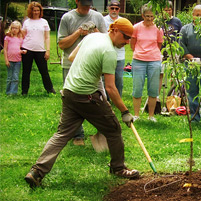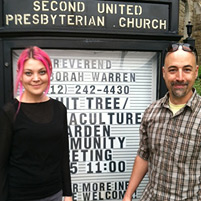Eco Art


Lazae LaSpina & Cem Akin. Photo by Ben Schmitt, Pop City Media
Experience art in a novel way. By eating it.
Fruit trees, berries and perennial edibles are used as the basis for a sustainable food source and as a community engagement garden in a new ecological art project.
Carnegie Mellon University's School of Art, the Fruit Tree Planting Foundation (FTPF), Pittsburgh Permaculture and the Second United Presbyterian Church of Wilkinsburg are the four partners on the project, which is located just outside of Pittsburgh in Wilkinsburg, Pa.
Ecological art — or "eco art" — is a contemporary form of environmental art created by artists who are concerned about local and global environmental situations. In the Wilkinsburg project, CMU provides the art form and its partners provide nature's components and volunteer support.
CMU's Bob Bingham, professor and associate head of the School of Art, and Lazae LaSpina, a Wilkinsburg resident and non-traditional CMU art student, created the project, which combines the elements of artistic design and function as they apply to living things.
"These contextual practice projects serve as catalysts to start conversations among people about ways to not only improve the landscape of their neighborhood, but also have a productive fruit and vegetable harvest," Bingham said.
Bingham is an "eco-art expert," having studied with Newton and Helen Harrison in the 70s at the University of California in San Diego. The Harrisons are often considered to be the founders of the eco-art movement.
The Community Engagement Gardens will see the development of three different types of permaculture gardens on two urban lots:
- organic gardening for local food production and stormwater management;
- an orchard forest garden and bioswale rain garden; and
- a community grazing garden.
LaSpina and Bingham were hoping to find a new project for her neighborhood when the garden opportunity presented itself in the form of Cem Akin (HNZ'98), executive director of the FTPF.
Akin grew up in the Pittsburgh area, had just returned from San Francisco and was looking for a local project.
"It seemed that all the elements were in place for a successful planting," Akin said. "Our goal is to provide communities with fruit tree orchards that will increase access to healthy foods and, in the process, clean the surrounding air, soil and water — creating critical green spaces that all residents value."
The Second United Presbyterian Church will offer the fresh organic harvest of this garden through its We Care food pantry.
Inspired by Fritz Haeg's Edible Estates (Haeg (A'92) received his CMU degree in architecture) and Mindy Schwartz's Garden Dreams Urban Farm & Nursery, LaSpina will design the rain and grazing gardens with Danielle Parnes, a CMU industrial design student.
Read the release for more details on the project and how to get involved.
Related Links: Environment at CMU | School of Art | Industrial Design
